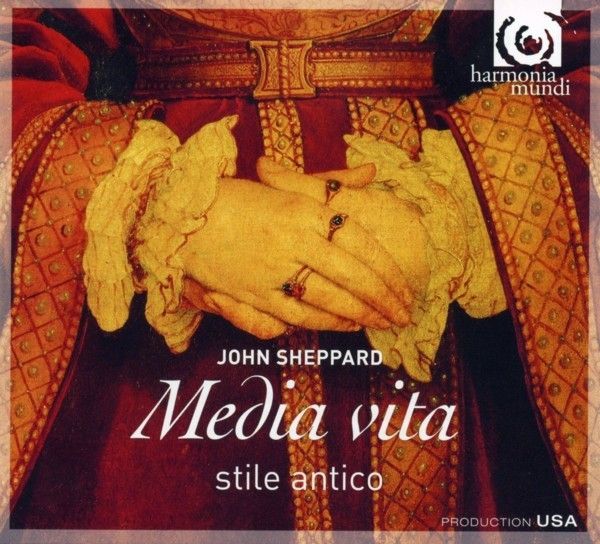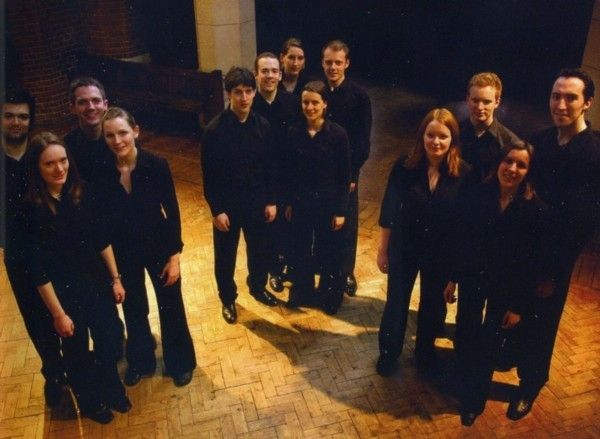
medieval.org
http://www.gramophone.net/Issue/Page/September%201996/85/761000/
Harmonia Mundi USA HMU 807509
2010

medieval.org
http://www.gramophone.net/Issue/Page/September%201996/85/761000/
Harmonia Mundi USA HMU 807509
2010
01 - Responsory. Gaude gaude gaude Maria virgo
[14:13]
Respond and Prose at 2nd Vespers, Feast of Candlemas
02 - The Lord's Prayer [4:19]
03 - Anthem. I give you a new commandment [3:00]
John 13:34-35
04 - Antiphon. Media vita [25:32]
Nunc dimittis Antiphon at Compline, 3rd & 4th Sundays in Lent
05 - Anthem. Christ rising again [4:23]
Book of Common Prayer, 1549: Romans 6:9-11, 1 Corinthians 15:20-22
06 - Anthem. Haste thee, O God [3:34]
Psalm 70
07 - Hymn. Te Deum, laudamus [15:14]
4th century Latin Hymn
The Book of Common Prayer. Verses from the Psalms
Stile Antico
Philip Thorby
Helen Ashby, Kate Ashby, Rebecca Hickey · sopranos
Emma Ashby, Eleanor Harries, Carris Jones · altos
Jim Clements, Julian Forbes, Andrew Griffiths, Benedict Hymas ·
tenors
Will Dawes, David Stuart · baritons
Oliver Hunt, Matthew O'Donovan · basses
Recorded at
All Hallows Church, Gospel Oak, London
March 2009

The early life of John Sheppard (c.1515-1558) remains a mystery.
Tradition holds that he was a chorister at St Paul's Cathedral, but the
first time he appears with any certainty is on his appointment to the
post of Informator Choristarum at Magdalen College, Oxford in
1543. He left Magdalen in 1548 to become a 'Gentleman of the Chapel
Royal', though the exact date of his taking up this post is uncertain.
He seems to have maintained some unofficial association with Magdalen
in the 1550s, though he is not to be confused with the unruly Richard
Shepper, a fellow of Magdalen, whose violent physical abuse of young
boys on two occasions in 1555 has at times been erroneously attributed
to the composer.
Sheppard can certainly be counted amongst the latecomers in the modern
revival of sixteenth-century music; it has only been in the last two or
three decades that his music has been performed or recorded in any
quantity, and even now his reputation still has a good deal of
catching-up to do. This is in stark contrast to his contemporary in the
Chapel Royal Thomas Tallis, for example, whose music has been in the
British choral repertoire for over a century.
There are several reasons for this apparent neglect. First, Sheppard's
music survives almost exclusively in manuscript form; much of Tallis's
music was published. Secondly, many of his Latin works are preserved in
an incomplete source, requiring time-consuming editorial reconstruction
in order to produce performing editions. As a result, these works did
not make it into the original Tudor Church Music edition in the
1920s, because the project was abandoned on financial grounds after
only ten of the projected twenty volumes had been completed. Thirdly,
the successful resurgence of many Tudor composers partly rested on
their English anthems which, until recent decades, were far more
welcome in the Anglican liturgy than Latin motets. Although some
enduring anthems have lasted from Edward VI's time (1547-53), it was
really under Elizabeth that the Tudor anthem reached its zenith;
Sheppard died barely a month after Elizabeth's accession. Fourthly,
Sheppard's music is frequently simply more difficult to sing than that
of his contemporaries, often spanning a vast vocal range, with disjunct
vocal lines and unexpected harmonic progressions common features;
furthermore, he had a penchant for writing music in many voice parts:
six is common in the Latin motets, and he further subdivides the parts
on a regular basis.
That Sheppard can be ranked amongst the very finest composers of his
generation, however, is in no doubt. His musical style is bold,
inventive, and thoroughly individual. His counterpoint is often dense,
more concerned with the colourful interweaving of his parts and the
harmonic effect than with strict imitative technique.
This programme presents a sample of his work in different liturgical
genres. As a general principle, the Latin works date from either the
reign of Mary I (1553-58) or Henry VIII (up to 1547). Of the three
included here, the Te Deum seems the most likely candidate for
an earlier date of composition on stylistic grounds, while Gaude,
gaude, gaude Maria and Media vita probably date from the
1550s. These Latin pieces provide the greatest scope for large-scale
composition, and each one is based on a plainchant melody presented as
a monorhythmic cantus firmus, around which Sheppard weaves intricate
counterpoint. By contrast, the English-texted anthems —probably
all Edwardine with the possible exception of The Lord's Prayer—
reflect the Protestant desire for textual clarity epitomised by
Archbishop Cranmer's personal preference for syllabic word setting.
The colossal antiphon Media vita ranks amongst the
largest-scale pieces of the entire century, and is certainly amongst
the most powerful in terms of its cumulative emotive effect. It is a
setting of a Lenten Nunc Dimittis antiphon at Compline — but its
scale seems to point beyond this liturgical purpose alone; it must
surely have been written with a particular event in mind. As Richard
Turbet has speculated, it may have been written in memory of Ludford,
who died in the summer of 1557, and whom, as a fellow parishioner of St
Margaret's, Westminster, Sheppard must have known well. Alternatively,
the influenza epidemic of 1557-59 — the deadliest to hit London
since the Black Death, and quite probably the cause of Sheppard's own
death — may well have provided the impetus for this most
soul-searching of pieces [1]. Its gravitas is evident from the very
opening; indeed, Sheppard could hardly have gone to greater lengths to
give the piece more weightiness: it is one of only a few works in which
he presents the cantus firmus in breves rather than semibreves.
Furthermore, the full sections of the piece are notated in
double-length note values compared with the shorter passages for
reduced forces, suggesting that a slow tempo is envisaged. The Nunc
Dimittis itself is presented in simple plainchant, as would have been
the liturgical custom in such an antiphon.
Equal in richness, but wholly different in mood is the magnificent
responsory Gaude, gaude, gaude Maria, which opens the
programme. This is Sheppard at his sunniest: the texture of the full
sections is warm and radiant, with luminous turns of harmony, a
strikingly developed tonal sense which seems several decades ahead of
its time, and colourful use of false relations. These sections are
interspersed with plainchant and with gymel passages in which the upper
two voices divide into four parts and are combined in turn with the
bass and contratenor voices. The Te Deum, another work of
impressive grandeur, is an alternatim setting of the medieval Latin
hymn and the petitions from the Psalms which traditionally follow it,
in which plainsong verses alternate with richly-scored polyphony in six
parts. It displays notable similarities with a similar setting by John
Taverner, which may well have influenced it.
Of the English anthems included, two are settings of texts which were
amongst the most commonly set during Edward's reign. Christ rising
again is a serenely joyful setting of the 'Easter Anthems' as
prescribed in the 1549 Book of Common Prayer. I give you a new
commandment is stylistically very similar, though smaller in scale,
with less jubilant melodic lines, and following the 'ABB' form so
popular amongst English anthems of the time. In both pieces, Sheppard
employs a tightly woven imitative texture with largely syllabic word
setting and passages of homophonic writing in order to ensure clear
declamation of the text.
The origin of the remaining two pieces is harder to pin down. Haste
thee, O God, recorded for the first time on this disc, has
traditionally been attributed to Sheppard, though of the four sources,
one ascribes it to Tye, whilst another gives the name Thomas Shepherd
— either a mistake, or a very obscure composer about whom we know
nothing else. Such conflicting attributions are commonplace in this
period, but the music doesn't particularly help us here. While it seems
to contain some traits in common with Sheppard's other English anthems
— indeed, it is full of vigour and character, and has many
appealing features — in other places it seems rather to lack his
consistency of invention and contrapuntal skill; perhaps the listener
should be left to reach his or her own verdict on its authenticity.
The splendid five-part setting of The Lord's Prayer is perhaps
the crowning glory of Sheppard's vernacular output, and we can be
grateful for its survival: it is transmitted in just one source of
which only the tenor part survives. Luckily, it appears in another
manuscript as an untexted viol piece; indeed, it is not inconceivable
that it started off life in this form. The appearance of the same piece
in two different guises in this way usually suggests that it was highly
regarded by the musicians of the day, and it is not difficult to see
why. The work's beautifully crafted vocal lines, carefully sustained
counterpoint and sublime touches of harmonic colour place it on a par
with the finest of his Latin music.
MATTHEW O'DONOVAN
1. David Skinner,
'Ludford, Sheppard, Fayrfax': correspondence with Richard Turbet, Early
Music 23,366-7.
